John F Lehman Jr
-
- The Posture Of The Navy Marine Corps Team — Fiscal Year 1984 — Maritime Reporter, Jun 1983 #21
Two years ago the President presented to Congress a program to reverse more than a decade of declining American military strength. In the preceding 10 years, real defense spending had declined 22 percent; our nuclear megatonage had been cut in half; our strategic bomber force had declined by 25 percent, our ballistic missile submarine force had dropped from 41 to 31; and our Navy had been slashed from nearly a thousand ships to 468, and from 23 aircraft carriers to 12.
During this same decade, the Soviet Union carried out one of the greatest peacetime military expansions in history. Since 1965, the Soviets increased military spending by about four percent real growth annually, nearly doubling their spending over that period. This growth, has been most noticeable in the Soviet Navy. Only a coastal defense force two decades ago, it is now a modern "bluewater" fleet capable of global power projection.
These adverse trends led the CNO to testify before Congress that the United States Navy no longer enjoyed superiority at sea.
In responding to this situation, President Reagan set a clear objective for the Navy and Marine Corps to regain clear maritime superiority within this decade.
As the President put it: "Though the Soviet Union is historically a land-power, virtually self-sufficient in mineral and energy resources and land linked to Europe and the vast stretches of Asia, it has created a powerful blue ocean Navy that cannot be justified by any legitimate defense need. It is a Navy built for offensive action, to cut free world supply lines and render impossible the support by sea of free world allies. By contrast, the United States is a naval power by necessity, critically dependent on the transoceanic import of vital strategic materials. Over 90'/'< of our commerce between continents moves in ships. Freedom to use the seas is our nation's lifeblood. For that reason, our Navy is designed to keep the sea lanes open world-wide.
Maritime superiority for us is a necessity. We must be able in time of emergency to venture in harm's way . . . to assure our access to all oceans of the world.
Failure to do so will leave the credibility of our conventional defense forces in doubt. We are . . . building a 600 ship fleet including 15 earl ier battle groups." Maritime superiority is but one element of our national strategy.
Nonetheless, it is a fundamental requirement, necessary for the success of any national strategy.
The program put before Congress two years ago to achieve this objective was built upon seven elements.
— First, a more realistic strategy for the use of Navy- Marine Corps forces to maximize their deterrence in peacetime, and to prevail if deterrence failed.
— Second, the restoration of the quality, training and morale of our personnel.
— Third, the enhancement of Navy and Marine Corps readiness through adequate maintenance, repair, spare parts and support.
— Fourth, the importance of our sea based nuclear deterrent, the most survivable and enduring component of the U.S. strategic triad.
— Fifth, the establishment of a shipbuilding, reactivation and conversion program to increase the force with the right kinds of ships and to save an industrial base on the verge of collapse.
— Sixth, to establish an aircraft modernization and procurement program to restore aircraft numbers and quality to meet operational requirements.
— Seventh, to build up stocks of ammunition and missiles to realistic objectives for sustaining combat.
The Navy and Marine Corps recovery program in pursuit of these objectives has been underway for two years. The budget for FY-84 will be the fourth Reagan defense recovery budget, counting the 1981 Supplemental and the 1982 revision. I am happy to report that the program is on course and we are moving closer to the achievement of many of our key objectives.
The effects are apparent everywhere in the Navy and Marine Corps. The dramatic benefits of these changes — greater strength, confidence, and capability — far outweigh the costs as we strive to meet the challenge of increasing Soviet military power.
The coming of Chairman Andropov to power has failed to produce any discernible change in the expansive thrust of Soviet m i l i t a r y strength. Thus the growth of Soviet naval capability and the emphasis on a global scope for its operations continues unabated.
During 1982, Soviet naval operations showed advances in sophistication and capability. For the first time, exercises were conducted by BACKFIRE bombers against U.S. carrier groups. We saw the first attempts by air-toair missile-armed FORGER V TOL aircraft to intercept U.S.
naval aircraft. Another new element was the participation of the carrier KIEV in support of Shield 82, a large Warsaw Pact exercise. In Southwest Asia, Cam Ranh Bay provided support for another innovation — a Soviet carrier battle group, headed by MINSK, deployed to the Indian Ocean. Closer to home, the dispatch of a task force to Cuba highlighted the increasing importance to the Soviet Navy of its Caribbean enclave.
Soviet and Warsaw Pact shipyards continued their steady stream of deliveries to the Soviet Navy during 1982. During 1983, we are expecting to see the first deployments of the third KIEV class carrier, the first of the nuclear-powered TYPHOON class ballistic missile submarines, and the initial BLACK-COM-1 class cruisers. The fourth KIEV class carrier is fitting out, and the second KIROV class nuclearpowered cruiser is nearing completion.
Large destroyers of the SOVREMENNYY and UDALOY classes continue in production at two major yards. There are seven submarine classes now in production.
Evidence mounts that a large conventional carrier program is underway. BACKFIRE bombers continue to enter the Soviet Naval Air Force. The new HELIX anti-submarine helicopter is beginning to replace the older HORMONE, and in 1982 HELIX was deployed for the first time on a carrier of the KIEV class.
Polish shipyards continued to supply amphibious warfare ships and repair ships to the Soviet Navy, despite the turmoil in that nation.
The USSR continues, in its role as the world's largest exporter of naval hardware, to devote a portion of its naval shipbuilding capacity to foreign exports. Cuba, in 1982, received more arms shipments from the USSR than in any year since 1962. Libya, Algeria, and India all received major deliveries of Soviet naval equipment.
Perhaps, even more important than the litany of new classes of Soviet naval ships and aircraft, is the incremental improvement of weapon and sensor systems that support those ships and aircraft. New missiles, guns, mines, torpedoes, radars and sonars are joining the Red Fleet, aided in part by the continued transfer of Western technology.
Soviet exploitation of Western scientific achievements constitutes a major threat, not only to our military forces, but also to the very fiber of the Western industrial economy.
The share of the Soviet defense budget allocated to the Soviet Navy has been steady for many years. As that budget grows in absolute terms, so does the capability of their fleet. I have highlighted some of the major programs and operations of the last year, but it is astonishing to view the across-the-board accomplishments of Soviet naval industry and the Soviet Fleet. A balanced naval force has been developed, with support requirements receiving attention along with combatant elements. It is this dedication to the broadest concept of seapower that permits the Soviet Navy to operate globally today.
In addition to the primary threat of Soviet naval and landbased forces, the United States Navy and Marine Corps must be able to cope with potential threats from other forces as well. Two recent incidents — in 1981 when U.S. forces were engaged by Libyan forces in the Gulf of Sidra, and the 1982 conflict in the Falklands, where anti-ship cruise missiles and nuclear attack submarines were used in combat for the first time, illustrate graphically that there is no "low threat area" for U.S. Navy and Marine Forces committed to a global mission.
In the face of these diverse threats, we set as a major goal the creation of a realistic strategy for the use of our forces.
Current naval strategy for the achievement of maritime objectives is built upon a number of fundamental premises. First, the Soviet threat to the maritime lifelines of the free world is now permanently deployed in every area of our vital interests. It follows that a conventional naval conflict between east and west cannot be limited to a single ocean region. Second, the global nature of our naval forces derives from the commitments of some forty treaty relationships.
For the Navy and Marine Corps these requirements are not matters of choice. They must all be met.
The implication of these two premises is far-reaching. The disposition of forces on both sides has changed dramatically in the past decade. In contrast to ten years ago, the Soviets now have a Pacific Fleet of some 765 ships and combatant craft, they operate from forward bases such as Cam Ranh Bay and DaNang in Vietnam. At the same time, the lower 48 United States have become dependent for one-third of their oil on the Alaskan sea lanes.
Thus, the United States can no longer consider abandoning one ocean to reinforce another in time of conventional war.
A third major premise is that the West can no longer rely on a passive defensive posture at sea. We do not have the merchant tonnage to sustain heavy losses in a submarine war of attrition as we did in World War II.
The Soviets today have over 280 attack submarines; Hitler began the second World War with fewer than 50 ocean-going submarines.
The Soviet's massive fleet of diesel and nuclear attack submarines, exercises regularly with the intention of wartime operations from areas much closer to the North Atlantic than the Kola Peninsula. Our response to the threat directed at our maritime vulnerability cannot simply be to throw a passive barrier across the Greenland-Iceland-UK gap.
We must be able to prevent the Soviets from gaining the initiative and thus enabling their submarines to prey on shipping in the Atlantic and Pacific.
Similarly, NATO must command the entire Mediterranean Sea if the security of the southern tier members of NATO is to be ensured. Let us not overlook an important consequence that flows from NATO control of the flanks. Successful achievement of NATO objectives on both flanks will compel the Soviets to divert forces, ultimately denying Moscow the advantage of concentrating all of its military power for an assault in central Europe.
Thus our maritime strategy must be based on a forward defense.
Such a successful strategy at sea is not, as some armchair strategists would suggest, an alternative to a coalition defense of Europe. Nor does it impede a strong, and modernized conventional land defense of NATO.
Instead, our maritime strategy complements these objectives. Its achievement is a necessary prerequisite for the success of any NATO defense. Similarly, in the Pacific and Indian Ocean theatres, favorable geography and the naval and land-based forces of the U.S. and its allies provide a clear strategy for success.
Much progress has been made in the past two years towards redesign of our peacetime forward deployments, our exercises, and our integration of Navy, Marine Corps, Air Force and Army assets to implement this strategy. Since World War II, Presidents have made use of forward deployed battle groups and Marine amphibious forces more than 250 times to preserve peace.
Regular forward naval deployments are recognized as stabilizing and a deterrent to conflict.
The Falklands offered a stark contrast. If the United Kingdom had indicated its intention to continue regular peacetime deployments to the Falklands, it might have avoided that tragic conflict.
But peacetime deployments are not merely to show resolve or to manage crises. For the Navy and the Marine Corps, they are also the best method to enhance training and readiness. In keeping with our new strategy, we have completley reordered our peacetime deployments to add more realistic multi-carrier operations, greater flexibility for theatre commanders, and far more useful training, while at the same time reducing the time spent away from homeport by Navy and Marine Corps personnel.
This new method of deployment, called "FLEXOPS", has resulted in multiple carrier exercises in the Norwegian Sea, the Eastern Mediterranean, the Caribbean and the Aleutians. It has significantly enhanced the readiness, morale, and flexibility of our naval forces.
In 1982, the Navy and the Marine Corps participated in more than 157 exercises world-wide, a third of which were joint or combined exercises with other U.S.
services or our allies. These operations were conducted in all types of conditions — arctic, desert, and jungle. The capabilities of our Marine amphibious forces continue to be dramatically demonstrated in Lebanon, where they are serving with great restraint under difficult conditions.
At the mid-point of the Regan naval recovery program it is evident that its success has been made possible by the dramatic reform of development and procurement in the Department of Defense. Two years ago, Secretary Weinberger reversed a long and disastrous trend towards centralization of management and diffusion of accountability. His leadership has brought about a new discipline and a new accountability.
Management authority has been returned to the Service Secretaries and far-reaching reforms have been undertaken. I would emphasize five key changes in the Department of the Navy: — First, stability in the program, avoiding the ragged ups and mostly downs of five year plans changing from year to year.
— Second, discipline and accountability in contracting, which involves a fair sharing of the risk between the government and its contractors, providing an incentive for increased profits for excellent performance, and con tractor assumption of the risk— and cost—of bad performance.
— Third, competition, not merely in source selection but in procurement through second sourcing wherever possible.
— Fourth, the firm disciplining of a habitual search for greater capabilities to meet ever increasing requirements. Unfortunately, the best can be the enemy of the good enough. Goldplating is now under control.
— Fifth, the investment in high technology to save money as well as increase capability.
Let me elaborate on this last point. Staying on the frontier of high technology is expensive. But a high technology approach has paid off handsomely to the Navy and to the taxpayers. High technology has provided our margins of superiority in virtually every important area, including that which is least understood — affordability.
For instance, twenty years ago a cruiser required 1,687 enlisted men and 116 officers.
Today the AEGIS cruiser— many times more capable than the vessel it replaces—is manned by 300 enlisted men and 26 officers.
Another good example is the F/A-18. Because of investment in high technology, this aircraft is currently requiring about one-third of the maintenance hours per flight hour of the aircraft it replaces. As a result, we are able to man F/A-18 squadrons with 50 fewer personnel than the aircraft squadrons they replace. This investment in high tech has paid off handsomely in aircraft safety as well. The current generation of naval aircraft, such as the F/A-18, has a safety record twenty times better than the so-called simple jet fighters of thirty years ago.
Results: As a result of the aggressive application of these management reforms, the original naval recovery program of two years ago is still on course despite a succession of budget cuts below President Reagan's initial plan. Some specific accomplishments have been: — Difficulties with the shipbuilding industry in constructing ships have been resolved.
After years of disputes, delays and overruns in our submarine construction programs, all submarines have been delivered on or ahead of schedule and within budget for the last year. For the first time in decades, there is not a single shipbuilding claim outstanding against the Navy.
— Aircraft Carriers. The contract for CVN-71, the Theodore Roosevelt, was renegotiated, reducing the price by nearly $100 million and shortening the contract delivery date by 14 months.
The contract for CVN-72 and CVN-73 was negotiated at an ex- pected savings to the taxpayer of $750 million.
— AEGIS Cruisers. Bath Iron Works was selected as a second source to compete with Litton for procurement of AEGIS cruisers in subsequent years.
— Battleships. New Jersey was recommissioned in December, 1982 — a two billion dollar weapon system for $326 million, five weeks ahead of schedule and under budget. This is a superb example of the prudent use of existing capital assets for which the previous generation of taxpayers has already paid.
— Build / Convert-and-Charter Programs. To obtain maritime prepositioning ships quickly and efficiently, we have turned to build/convert-and-charter programs.
Studies have shown that in terms of present value, we will save over $35 million per ship by chartering rather than purchasing.
After accounting for tax aspects, the savings to the Treasury will still be over $28 million per ship. The contracts are for cargo-carrying services which were awarded competitively at prices that will save the American taxpayers millions of dollars. The program also provides a positive impetus to the beleaguered U.S. Merchant Marine and to the depressed U.S.
shipbuilding industry. Without such work, many of these shipyards would have closed. They remain in business today providing jobs and an industrial base for the Navy of the future.
Overall in shipbuilding, 25 ships were delivered to the Navy during 1982. Twenty ships were a total of 11 months ahead of schedule. Nineteen ships were on or below budget.
These and other management initiatives have already resulted in such efficiencies that, despite some cuts in previous Navy budgets, we remain on course. The American taxpayer is clearly getting his dollar's worth of national security from the naval recovery program.
Two years ago we set forth a program intended to recapture maritime superiority for the United States. It was based on a 600-ship Navy, built around 15 battle groups. At that time, some said it would not be done— that such a Navy would detract from other commitments, that both technology and innovation in naval warfare made surface ships vulnerable and obsolete.
Others said that it could not be done, that we lacked the ships, the money, the men, and above all, the management capability to oversee such an undertaking.
But events over the past two years have confounded the critics.
The continued growth of Soviet forces and the Falklands conflict have confirmed our choices. The 600-ship Navy is well on its way. Accompanying the expansion of force structure has been an increasing recruitment of high quality personnel. Existing forces have been made more ready. Morale is high. We have demonstrated that we can manage the naval recovery program effectively, with many elements delivered ahead of schedule and under budget. We have tried very hard to be worthy of the confidence placed in us by the Congress and the American people.
Strategic planning, capable management and skilled personnel, are not however, the only requisites for achievement of our goals. As Disraeli so aptly put it, "The secret of success is constancy of purpose." At this mid-point in our naval recovery program, the secret of success is, indeed, the constancy of our purpose. The United States is well on its way toward maritime superiority. I am certain that we shall achieve it.
-
- Nuclear-Powered Sub 'Houston' Launched At Newport News Yard Maritime Reporter, May 15, 1981 #39
. Bush christened the Houston by breaking the traditional bottle of champagne against the ship's bow. The Bushes are Houstonians. Secretary of the Navy John F. Lehman Jr. also spoke. Mrs. Mary Ann Bertles Stewart, wife of Supreme Court Justice Potter Stewart, was the matron of honor. The keel for the
-
- Lockheed Launches U.S. Navy Dock Landing Ship 'Germantown' Ahead Of Schedule Maritime Reporter, Aug 1984 #8
again— this time by the Southerners, to prevent the Union forces from capturing her. Mrs. Kelley was named the ship's sponsor by Secretary of the Navy John F. Lehman Jr. The Secretary named her husband, General Kelly, Commandant of the U.S. Marine Corps, principal speaker at the launching ceremony
-
- First Aegis Missile Cruiser Christened At Ingalls Yard Maritime Reporter, Jun 15, 1981 #58
air defense radar and missile system in the world. Speakers on the program included Secretary of Defense Caspar W. Weinberger; Mississippi Senator John C. Stennis; Mississippi Congressman Trent Lott, House Minority Whip; Secretary of the Navy John F. Lehman Jr.; Chief of Naval Operations Adm. Thomas
-
- U.S. SHIPBUILDING INDUSTRY HAS MADE GREAT STRIDES IN IMPROVING EFFICIENCY AND REDUCING COSTS Maritime Reporter, Jun 1986 #44
Navy should meet its 600-ship goal by the end of this decade. President Reagan, Secretary of Defense Caspar W. Weinberger, and Secretary of the Navy John F. Lehman Jr. are to be commended for their steadfastness in sticking to this objective. The advent of Gramm/Rudman/ Hollings, with its laudable
-
- 89th SNAME Annual Meeting Maritime Reporter, Nov 1981 #10
will convene at The New York Hilton Hotel, New York, N.Y. on November 19-21, 1981. "This is by far the Society's largest annual event," stated John J. Nachtsheim, president of the Society, "with more than 1,000 people from all segments of the maritime industry gathering to hear the technical
-
- NEW NAVY BUDGET: OVER $100 BILLION Maritime Reporter, Mar 1986 #22
shipbuilding plan are required by law to be submitted to Congress), but the Weinberger report and the "posture" statements submitted by Navy Secretary John F. Lehman Jr. and Chief of Naval Operations Adm. James D. Watkins all say much the same thing: ships now operational will be kept in service longer
-
- NAVY WORK IN PRIVATE U.S. YARDS Maritime Reporter, Aug 15, 1984 #20
gallons of petroleum products in bulk and 81,000 gallons of potable water. The Quincy yard has laid the keels for the first two ships, and 2nd Lt. John P. Bobo and the Pfc. Dewayne T. Williams. All of the MPS vessels will be named for servicemen who earned the Medal of Honor. Circle 15 on Reader
-
 )
March 2024 - Marine Technology Reporter page: 4
)
March 2024 - Marine Technology Reporter page: 4; Fax: (212) 254-6271 tional in London, perennially one Lof the world’s most important Justin Zuure CEO events serving the global subsea market. John C. O’Malley [email protected] Personally, it was my ? rst return to London for this event since 2018, as the 2020 ‘50th Anniversary’ edition
-
 )
April 2024 - Maritime Reporter and Engineering News page: 28
)
April 2024 - Maritime Reporter and Engineering News page: 28to provide all of the end-to-end logistics the force will require in a future major con? ict. U.S. Navy photo by Mass Communication Specialist 2nd Class John Bellino 28 Maritime Reporter & Engineering News • April 2024 MR #4 (18-33).indd 28 4/5/2024 8:27:05 A
-
 )
April 2024 - Maritime Reporter and Engineering News page: 27
)
April 2024 - Maritime Reporter and Engineering News page: 27Sailors. We have 14 Henry J. Kaiser-class ? eet replen- high-speed craft (HSC) training. So, MyMSC will help track ishment oilers and three of the new John Lewis class of ? eet and manage all of those different things in one place. We’re replenishment oilers, with more on the way. We have 14 Lew- hoping
-
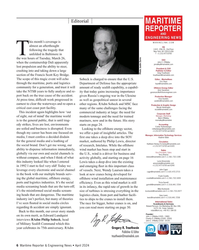 )
April 2024 - Maritime Reporter and Engineering News page: 6
)
April 2024 - Maritime Reporter and Engineering News page: 6St., 2nd Floor following the tragedy that New York, NY 10010 USA T +1.212.477.6700 Tunfolded in Baltimore in the wee hours of Tuesday, March 26, CEO John C. O’Malley when the containership Dali apparently [email protected] lost propulsion and the ability to steer, President & COO Publisher & Editor cra
-
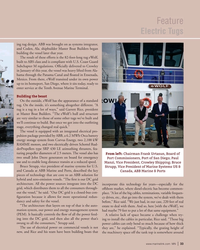 )
April 2024 - Marine News page: 33
)
April 2024 - Marine News page: 33SRP 430 LE azimuthing thrusters, fea- turing propeller diameters of 2.5 meters. The vessel also has From left: Chairman Frank Urtasun, Board of two small John Deere generators on board for emergency Port Commissioners, Port of San Diego; Paul use and to enable long distance transits at a reduced speed. Manzi
-
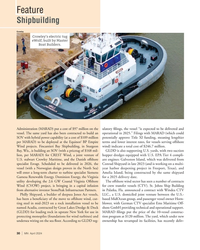 )
April 2024 - Marine News page: 30
)
April 2024 - Marine News page: 30The offshore wind sector has seen a number of contracts Wind (CVOW) project, is bringing in a capital infusion for crew transfer vessels (CTV). St. Johns Ship Building from alternative investor StonePeak Infrastructure Partners. in Palatka, Fla. announced a contract with Windea CTV Philly Shipyard
-
 )
April 2024 - Marine News page: 4
)
April 2024 - Marine News page: 4.marinelink.com The current period of time is one of swift transition for the maritime industry, CEO as regulatory and technological evolutions John C. O’Malley • [email protected] increasingly make their presence felt across Publisher & Editorial Director Greg Trauthwein • trauthwein@marinelink
-
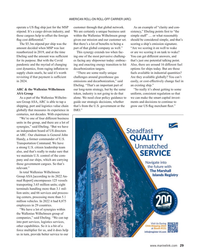 )
February 2024 - Maritime Reporter and Engineering News page: 29
)
February 2024 - Maritime Reporter and Engineering News page: 29units in the group, and there are a lot of synergies,” said Ebeling. “But we have an independent board of US directors at ARC. Our chairman is General John Handy, a former commander of U.S. Transportation Command. We have a strong U.S. citizen leadership team also, and that’s really to make sure that
-
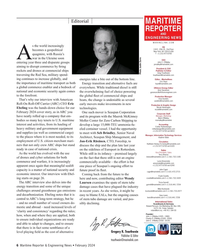 )
February 2024 - Maritime Reporter and Engineering News page: 6
)
February 2024 - Maritime Reporter and Engineering News page: 6HQ 118 E. 25th St., 2nd Floor becomes a geopolitical New York, NY 10010 USA T +1.212.477.6700 quagmire, with Russia’s Awar in the Ukraine soon CEO John C. O’Malley entering year three and disparate groups [email protected] aiming to disrupt commerce by ? ring President & COO Publisher & Editor rocke
-
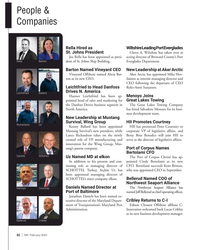 )
February 2024 - Marine News page: 42
)
February 2024 - Marine News page: 42People & Companies Rella Hired as Wiltshire Leading Port Everglades St. Johns President Glenn A. Wiltshire has taken over as Joe Rella has been appointed as presi- acting director of Broward County’s Port Rella Barton dent of St. Johns Ship Building. Everglades Department. Barton Named Vineyard CEO New
-
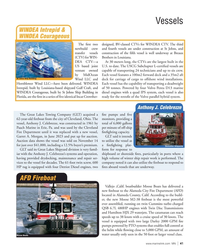 )
February 2024 - Marine News page: 41
)
February 2024 - Marine News page: 41& WINDEA Courageous The ? rst two designed, BV-classed CTVs for WINDEA CTV. The third newbuild crew and fourth vessels are under construction at St Johns, and transfer vessels construction of the ? fth vessel is well underway at Breaux (CTV) for WIN- Brothers in Louisiana. DEA CTV—a At 30 meters long
-
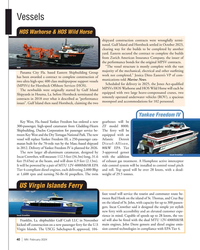 )
February 2024 - Marine News page: 40
)
February 2024 - Marine News page: 40Islands Ferry foot vessel will service the tourist and commuter route be- tween Red Hook on the island of St. Thomas, and Cruz Bay on the island of St. John, with capacity for up to 300 passen- gers. Incat Crowther said it designed the simple yet stylish new ferry with accessibility and an elevated customer
-
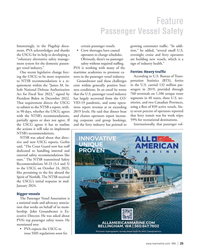 )
February 2024 - Marine News page: 25
)
February 2024 - Marine News page: 25mid- January 2024. Bigger vessels The Passenger Vessel Association is a national trade and advocacy associa- tion that works on behalf of its mem- bership. John Groundwater is Ex- ecutive Director. He was asked about PVA’s top passenger safety issues. He mentioned two: • PVA expects the USCG to issue SMS
-
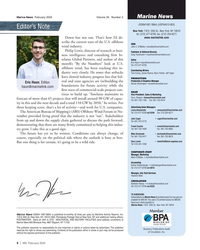 )
February 2024 - Marine News page: 4
)
February 2024 - Marine News page: 4477-6700; fax: (212) 254-6271 www.marinelink.com Down but not out. That’s how I’d de- scribe the current state of the U.S. offshore CEO wind industry. John C. O’Malley • [email protected] Philip Lewis, director of research at busi- Publisher & Editorial Director Greg Trauthwein • trauthwein@marinelink
-
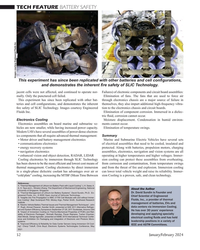 )
January 2024 - Marine Technology Reporter page: 52
)
January 2024 - Marine Technology Reporter page: 52Smith, Southwest Research Institute management of batteries, EVs and 4. “Electric Vehicle Battery Thermal Issues and Thermal Management Techniques”, John data centers via Immersion Cooling. P. Rugh, Ahmad Pesaran, Kandler Smith; presented at SAE 2011 Alternative Refriger- ant and System Ef? ciency
-
 )
January 2024 - Marine Technology Reporter page: 4
)
January 2024 - Marine Technology Reporter page: 4(though not for attribution or reporting) Justin Zuure on the path, direction and importance of the CEO subsea vehicle market. Sitting at that table John C. O’Malley [email protected] that night were several U.S. Navy Admirals as well as the CEOs from about a dozen autonomous underwater vehicle
-
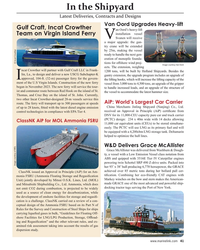 )
January 2024 - Maritime Reporter and Engineering News page: 41
)
January 2024 - Maritime Reporter and Engineering News page: 41ist and commuter route between Red Hook on the island of St. the vessel to accommodate the latest hammer size. Thomas, and Cruz Bay on the island of St. John. Currently, two other Incat Crowther-designed 28-m vessels service this AiP: World’s Largest Car Carrier route. The ferry will transport up to 300
-
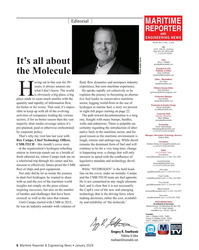 )
January 2024 - Maritime Reporter and Engineering News page: 6
)
January 2024 - Maritime Reporter and Engineering News page: 6Editorial MARITIME REPORTER AND ENGINEERING NEWS M A R I N E L I N K . C O M HQ 118 E. 25th St., 2nd Floor New York, NY 10010 USA T +1.212.477.6700 CEO John C. O’Malley It’s all about [email protected] President & COO Publisher & Editor Greg Trauthwein the Molecule Photo Justin Zurre trauthwein@marinelink
-
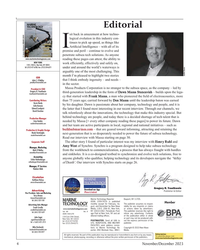 )
November 2023 - Marine Technology Reporter page: 4
)
November 2023 - Marine Technology Reporter page: 4is arguably one of the most challenging. This Justin Zuure month I’m pleased to highlight two stories CEO that I think embody ingenuity – and needs – John C. O’Malley [email protected] in the sector. Massa Products Corporation is no stranger to the subsea space, as the company – led by President
-
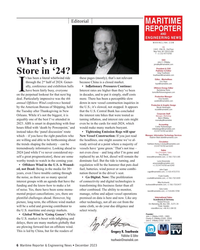 )
December 2023 - Maritime Reporter and Engineering News page: 6
)
December 2023 - Maritime Reporter and Engineering News page: 6Editorial MARITIME REPORTER AND ENGINEERING NEWS M A R I N E L I N K . C O M HQ 118 E. 25th St., 2nd Floor New York, NY 10010 USA T +1 212 477 6700 CEO John C. O’Malley What’s in [email protected] President & COO Publisher & Editor Greg Trauthwein Store in ‘24? [email protected] t has been
-
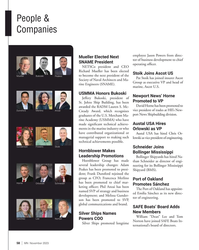 )
November 2023 - Marine News page: 58
)
November 2023 - Marine News page: 58VP and head of rine Engineers (SNAME). marine, Ascot U.S. USMMA Honors Bukoski Newport News’ Horne Jeffery Bukoski, president of Promoted to VP St. Johns Ship Building, has been David Horne has been promoted to awarded the RADM Lauren S. Mc- Merlino Dunsford Anzai Cready Award, which recognizes
-
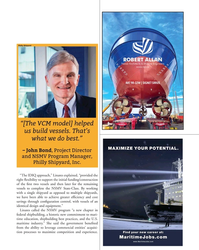 )
November 2023 - Marine News page: 41
)
November 2023 - Marine News page: 41Philly Shipyard “[The VCM model] helped us build vessels. That’s what we do best.” – John Bond, Project Director and NSMV Program Manager, Philly Shipyard, Inc. “The IDIQ approach,” Linares explained, “provided the right ? exibility to support the initial funding/construction of the ? rst two
-
 )
November 2023 - Marine News page: 39
)
November 2023 - Marine News page: 39up to ? ve NSMVs. Keel laying for the Empire State was in May 2021. Ben Christian is TOTE Services’ VP for Business Devel- opment and New Construction. John Bond is Project Di- rector and NSMV Program Manager for Philly Shipyard, Inc. The two were asked for their insights and advisories about the VCM process
-
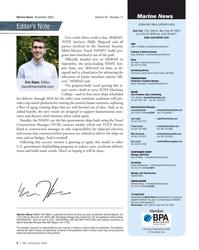 )
November 2023 - Marine News page: 4
)
November 2023 - Marine News page: 4254-6271 www.marinelink.com Give credit where credit is due. MARAD, TOTE Services, Philly Shipyard and all CEO parties involved in the National Security John C. O’Malley • [email protected] Multi-Mission Vessel (NSMV) build pro- Publisher & Editorial Director Greg Trauthwein • trauthwein@marinelink
